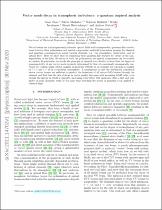 ResearchSpace
ResearchSpace
Vector-mode decay in atmospheric turbulence: An analysis inspired by quantum mechanics
JavaScript is disabled for your browser. Some features of this site may not work without it.
- ResearchSpace
- →
- Research Publications/Outputs
- →
- Journal Articles
- →
- View Item
| dc.contributor.author |
Nape, I

|
|
| dc.contributor.author |
Mashaba, Nikiwe P

|
|
| dc.contributor.author |
Mphuthi, N

|
|
| dc.contributor.author |
Jayakumar, S

|
|
| dc.contributor.author |
Bhattacharya, S

|
|
| dc.contributor.author |
Forbes, Andrew

|
|
| dc.date.accessioned | 2021-06-23T09:06:53Z | |
| dc.date.available | 2021-06-23T09:06:53Z | |
| dc.date.issued | 2021-03 | |
| dc.identifier.citation | Nape, I., Mashaba, N.P., Mphuthi, N., Jayakumar, S., Bhattacharya, S. & Forbes, A. 2021. Vector-mode decay in atmospheric turbulence: An analysis inspired by quantum mechanics. <i>Physical Review Applied, 15(3).</i> http://hdl.handle.net/10204/12026 | en_ZA |
| dc.identifier.issn | 2331-7019 | |
| dc.identifier.uri | https://doi.org/10.1103/PhysRevApplied.15.034030 | |
| dc.identifier.uri | http://hdl.handle.net/10204/12026 | |
| dc.description.abstract | Vector beams are inhomogeneously polarized optical fields with nonseparable, quantum-like correlations between their polarization and spatial components, and hold tremendous promise for classical and quantum communication across various channels, e.g. the atmosphere, underwater, and in optical fibre. Here we show that by exploiting their quantum-like features by virtue of the non-separability of the field, the decay of both the polarization and spatial components can be studied in tandem. In particular, we invoke the principle of channel state duality to show that the degree of nonseparability of any vector mode is purely determined by that of a maximally nonseparable one, which we confirm using orbital angular momentum (OAM) as an example for topological charges of l=1 and l=10 in a turbulent atmosphere. A consequence is that the well-known cylindrical vector vortex beams are sufficient to predict the behaviour of all vector OAM states through the channel. the of decay in vector quality decreases with increasing OAM value, even though the spread in OAM is opposite, with increasing OAM. Our approach offers a fast and easy probe of noisy channels, while at the same time revealing the power of quantum tools applied to classical light | en_US |
| dc.format | Fulltext | en_US |
| dc.language.iso | en | en_US |
| dc.relation.uri | https://journals.aps.org/prapplied/accepted/ee07aA4cLc81e600d22d7e87ec167f1c66bd6dc6f | en_US |
| dc.source | Physical Review Applied, 15(3) | en_US |
| dc.subject | Atmospheric turbulence | en_US |
| dc.subject | Orbital Angular Momentum | en_US |
| dc.subject | OAM | en_US |
| dc.subject | Cylindrical Vector Vortex | en_US |
| dc.subject | CVV | en_US |
| dc.subject | Vector beams | en_US |
| dc.title | Vector-mode decay in atmospheric turbulence: An analysis inspired by quantum mechanics | en_US |
| dc.type | Article | en_US |
| dc.description.pages | 9pp | en_US |
| dc.description.note | © 2021 American Physical Society. Due to copyright restrictions, the attached PDF file only contains the preprint of the full text item. For access to the full text item, kindly consult the publisher's website: https://journals.aps.org/prapplied/accepted/ee07aA4cLc81e600d22d7e87ec167f1c66bd6dc6f | en_US |
| dc.description.cluster | Defence and Security | en_US |
| dc.description.impactarea | Optronic Sensor Systems | en_US |
| dc.identifier.apacitation | Nape, I., Mashaba, N. P., Mphuthi, N., Jayakumar, S., Bhattacharya, S., & Forbes, A. (2021). Vector-mode decay in atmospheric turbulence: An analysis inspired by quantum mechanics. <i>Physical Review Applied, 15(3)</i>, http://hdl.handle.net/10204/12026 | en_ZA |
| dc.identifier.chicagocitation | Nape, I, Nikiwe P Mashaba, N Mphuthi, S Jayakumar, S Bhattacharya, and Andrew Forbes "Vector-mode decay in atmospheric turbulence: An analysis inspired by quantum mechanics." <i>Physical Review Applied, 15(3)</i> (2021) http://hdl.handle.net/10204/12026 | en_ZA |
| dc.identifier.vancouvercitation | Nape I, Mashaba NP, Mphuthi N, Jayakumar S, Bhattacharya S, Forbes A. Vector-mode decay in atmospheric turbulence: An analysis inspired by quantum mechanics. Physical Review Applied, 15(3). 2021; http://hdl.handle.net/10204/12026. | en_ZA |
| dc.identifier.ris | TY - Article AU - Nape, I AU - Mashaba, Nikiwe P AU - Mphuthi, N AU - Jayakumar, S AU - Bhattacharya, S AU - Forbes, Andrew AB - Vector beams are inhomogeneously polarized optical fields with nonseparable, quantum-like correlations between their polarization and spatial components, and hold tremendous promise for classical and quantum communication across various channels, e.g. the atmosphere, underwater, and in optical fibre. Here we show that by exploiting their quantum-like features by virtue of the non-separability of the field, the decay of both the polarization and spatial components can be studied in tandem. In particular, we invoke the principle of channel state duality to show that the degree of nonseparability of any vector mode is purely determined by that of a maximally nonseparable one, which we confirm using orbital angular momentum (OAM) as an example for topological charges of l=1 and l=10 in a turbulent atmosphere. A consequence is that the well-known cylindrical vector vortex beams are sufficient to predict the behaviour of all vector OAM states through the channel. the of decay in vector quality decreases with increasing OAM value, even though the spread in OAM is opposite, with increasing OAM. Our approach offers a fast and easy probe of noisy channels, while at the same time revealing the power of quantum tools applied to classical light DA - 2021-03 DB - ResearchSpace DP - CSIR J1 - Physical Review Applied, 15(3) KW - Atmospheric turbulence KW - Orbital Angular Momentum KW - OAM KW - Cylindrical Vector Vortex KW - CVV KW - Vector beams LK - https://researchspace.csir.co.za PY - 2021 SM - 2331-7019 T1 - Vector-mode decay in atmospheric turbulence: An analysis inspired by quantum mechanics TI - Vector-mode decay in atmospheric turbulence: An analysis inspired by quantum mechanics UR - http://hdl.handle.net/10204/12026 ER - | en_ZA |
| dc.identifier.worklist | 24329 | en_US |





